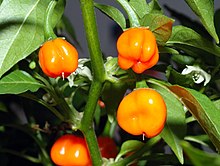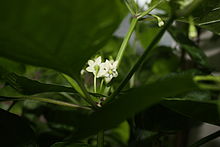Capsicum chinense
| Capsicum chinense | |
|---|---|

| |
| Habanero fruits | |
| Scientific classification | |
| Kingdom: | |
| (unranked): | |
| (unranked): | |
| (unranked): | |
| Order: | |
| Family: | |
| Genus: | |
| Species: | C. chinense
|
| Binomial name | |
| Capsicum chinense | |
| Synonyms[1] | |
| |
Capsicum chinense, commonly known as "yellow lantern chili",[2] is a species of chili pepper native to the Americas. C. chinense varieties are well known for their exceptional heat. Some taxonomists consider them to be part of the species C. annuum.[3][4]
Taxonomy
Despite its name, C. chinense or "Chinese capsicum" is misleading. All Capsicum species originated in the New World. Nikolaus Joseph von Jacquin (1727–1817), a Dutch botanist, erroneously named the species in 1776, because he believed they originated in China.[5]
Plant appearance

Within C. chinense, the appearance and characteristics of the plants can vary greatly. Varieties such as the well-known habaneros grow to form small, compact perennial bushes about 0.5 m in height. The flowers, as with most Capsicum species, are small and white with five petals. When it forms, the fruit varies greatly in colour and shape,[6] with red, orange, and yellow being the most common final colours, but colours such as brown are also known. Another similarity with other species would be shallow roots, which are very common.
Distribution
C. chinense is native to Central America, the Yucatan region, and the Caribbean islands. In warm climates such as these, it is a perennial and can last for several years, but in cooler climates, C. chinense does not usually survive the winter. However, it will readily germinate from the previous year's seed in the following growing season.
Cultivation and agriculture
C. chinense peppers have been cultivated for hundreds of years in their native regions, but have only recently been introduced to areas of Asia, where they are also farmed. They are popular with many gardeners for their bright colours (ornamental value) and for their fruit in vegetable gardens.
Culinary use
C. chinense and its varieties have been used for centuries in Yucatan and Caribbean-style cooking to add a significant amount of heat to their traditional food.[7] They are mainly used in stews and sauces, as well as marinades for meats and chicken.
Western food at times also uses some of these chiles. For example, habaneros (a group of C. chinense varieties) are commonly used in hot sauces and extra-spicy salsas, due to the popularity of Tex-Mex and Mexican cuisines in Western culture.[8]
Common C. chinense varieties
Like C. annuum, C. chinense has many different varieties, including:
- 7-Pot chili (Trinidad)
- 7-Pot cultivar 7-Pot Primo
- Adjuma (Suriname)
- Ají Panca (Peru)
- Arriba Saia (Brazil)
- 'Carolina Reaper' (South Carolina)
- Datil (Florida)
- Fatalii (south central Africa)
- Habanero chile (Caribbean, Central America and Mexico)
- Habanero cultivar 'Red Savina'
- Hainan yellow lantern chili (Hainan Island, South China)
- 'Madame Jeanette' (Suriname)
- Bhut jolokia (Assam)
- Bhut jolokia cultivar 'Dorset' Naga pepper
- Scotch bonnet (Jamaica, Trinidad)
- Trinidad moruga scorpion (Trinidad)
- Trinidad moruga scorpion cultivar Trinidad scorpion 'Butch T'
References
- ^ "The Plant List".
- ^ "Rikke's Plants Capsicum Chinense". Rikke's Plants. Rikke's Plants. Retrieved 8 May 2011.
- ^ "Tropicos".
{{cite web}}:|chapter=ignored (help) - ^ Eshbaugh, W.H. (1993). "History and exploitation of a serendipitous new crop discovery". In J. Janick and J.E. Simon (ed.). New crops. New York: Wiley. pp. 132–139.
- ^ Bosland, P.W. 1996. Capsicums: Innovative uses of an ancient crop. p. 479-487. In: J. Janick (ed.), Progress in new crops. ASHS Press, Arlington, VA.
- ^ "Chinense Species". Capsicum Species. TheChilliMan.biz. Retrieved 8 May 2011.
- ^ Webster, Valerie. "Habanero Hot Sauce - Cure for Common Cuisine". Caribbean Coice Recipes. Caribbean Choice. Retrieved 7 May 2011.
- ^ "Mexican American culture". Kwintessential Publications. Kwintessential. Retrieved 7 May 2011.
